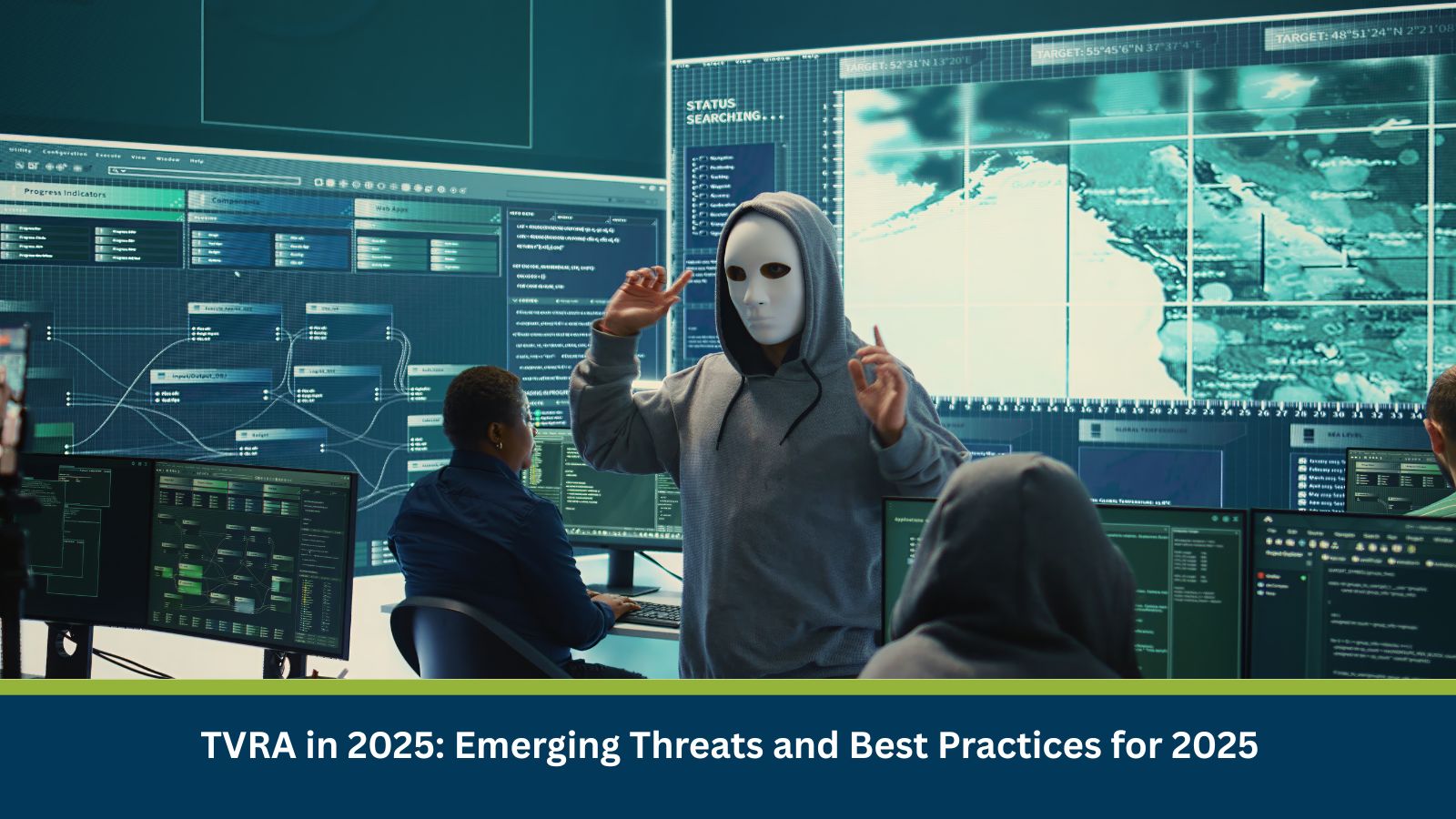Why TVRA Matters in Physical Security
A Threat, Vulnerability, and Risk Assessment (TVRA) is a cornerstone of physical security planning. Organizations with high-value assets, critical operations, or sensitive data face complex threats ranging from terrorism and insider sabotage to natural disasters and social unrest. A well-executed TVRA in physical security identifies potential attackers, analyzes vulnerabilities in facilities, and prioritizes countermeasures to reduce exposure.
According to ASIS International, a robust TVRA can uncover threats and vulnerabilities that organizations often overlook, enabling proactive investments in security controls.
To know more about TVRA, read here
Key Physical Threats in 2025
Insider Threats and Employee Sabotage
Employees and contractors with access to critical facilities pose one of the most underestimated risks. Disgruntled insiders can bypass controls, leak information, or damage assets. A TVRA must assess insider vulnerabilities and integrate access control and behavioral monitoring systems.
Terrorism and Active Threat Scenarios
High-profile facilities, such as corporate headquarters, airports, energy plants, and financial hubs, remain potential targets for terrorism. Assessing blast resistance, evacuation routes, and perimeter defenses is a vital component of TVRA in physical security.
Civil Unrest and Protest Movements
Organizations in urban centers face risks from demonstrations, riots, and civil unrest. TVRA methodologies now incorporate social intelligence and threat modeling to predict potential disruptions and develop security contingency plans.
Natural Disasters and Environmental Hazards
From flooding and wildfires to earthquakes and extreme weather, natural threats are a growing concern in risk management. Physical security TVRAs assess building resilience, backup power systems, and disaster recovery capabilities.
Supply Chain and Infrastructure Dependencies
Organizations often underestimate physical interdependencies, such as reliance on transport, utilities, or third-party warehouses. A future-ready TVRA must map critical dependencies and evaluate contingency plans in case of disruption.
Best Practices for TVRA in Physical Security
Holistic Asset Mapping
Begin by identifying all critical assets, people, infrastructure, technology, and reputational elements. Map vulnerabilities such as unmonitored entry points, weak perimeter fencing, or inadequate surveillance coverage.
Integrated Threat Modelling
A strong TVRA doesn’t just assess what could go wrong but also who the threat actors are and how they might strike. Integrating scenario-based threat modeling ensures a more realistic assessment of physical security risks.
Prioritization of Risks
Not all vulnerabilities are equal. A broken CCTV camera may be less critical than an unsecured server room. Using a likelihood vs. impact matrix, TVRA helps organizations prioritize physical security risks and allocate budgets effectively.
Integration with Cybersecurity Assessments
In 2025, physical and digital security are interdependent. For example, an attacker might physically breach a data center to install malware. A future-ready TVRA must assess both physical controls (guards, locks, sensors) and cyber-physical systems (IoT devices, access management software).
Actionable Security Roadmaps
The most valuable output of a TVRA is a clear action plan, what needs to be fixed, who is responsible, and what resources are required. This ensures findings translate into real-world security improvements instead of sitting in a report.
Why Risk Professionals Should Act Now
- Threats are Dynamic: Physical threats evolve with geopolitics, climate change, and urban unrest.
- Regulatory Pressures: Industries like aviation, critical infrastructure, and banking are embedding TVRA into compliance requirements.
- Cost of Inaction: Business interruption (often triggered by physical threats) remains among the top three global risks.
By embedding TVRA in physical security, organizations can reduce blind spots, improve resilience, and demonstrate due diligence to regulators, investors, and stakeholders.
Frequently Asked Questions (FAQs) on TVRA in Physical Security
What is TVRA in physical security?
TVRA in physical security stands for Threat, Vulnerability, and Risk Assessment, a structured process used to identify, analyze, and mitigate risks to physical assets, facilities, and people. It helps organizations anticipate threats like terrorism, insider attacks, or natural disasters, and strengthen resilience strategies.
Why is TVRA important for physical security in 2025?
In 2025, organizations face complex and evolving threats such as terrorism, civil unrest, and extreme weather events. A TVRA in physical security ensures that organizations are not only compliant with regulatory requirements but also resilient against both traditional and emerging risks.
How often should organizations conduct a TVRA?
Best practice suggests conducting a TVRA at least once every 12–18 months, or whenever there are significant operational, environmental, or geopolitical changes. Regular assessments ensure vulnerabilities are updated in line with new threats.
What types of threats are assessed in a physical security TVRA?
A physical security TVRA typically covers:
- Insider threats (employee sabotage, theft)
- Terrorism and active shooter incidents
- Civil unrest, riots, and protests
- Natural disasters (floods, earthquakes, wildfires)
- Infrastructure dependencies (power, utilities, logistics)
How does TVRA in physical security differ from cybersecurity risk assessment?
While cybersecurity risk assessments focus on digital threats (e.g., hacking, malware, ransomware), TVRA in physical security focuses on tangible risks to people, property, and facilities. However, in 2025, both assessments are increasingly integrated, since attackers may exploit both physical and digital vulnerabilities.
What is the outcome of a physical security TVRA?
A successful TVRA in physical security produces a risk prioritization roadmap with clear actions, timelines, and responsibilities. It enables security managers to allocate budgets effectively, improve resilience, and demonstrate due diligence to regulators and stakeholders.
Who should conduct a TVRA in physical security?
A TVRA should be carried out by qualified risk consultants or internal security experts with experience in facility security, crisis management, and risk modeling. Partnering with a specialist risk advisory firm ensures the methodology is robust, defensible, and aligned with industry best practices.
Conclusion
Physical security in 2025 is no longer about guards, gates, and guns, it’s about intelligence-driven, risk-based resilience planning. A well-executed TVRA identifies evolving threats like insider sabotage, terrorism, civil unrest, and natural disasters, while providing actionable roadmaps for mitigation.
For risk managers, the message is clear: organizations that invest in future-ready TVRA practices today will be better equipped to face tomorrow’s uncertainties with confidence.
Partner with MitKat to build a robust Threat Vulnerability Risk Assessment
Mitkat helps organisations to navigate through an uncertain evolving security landscape and disruptive events that hamper business continuity. We ensure that our tailor-made risk assessments and risk-mitigating strategies help increase the security resilience of organisations. Our AI-powered operational risk monitoring tool, datasurfr combined with experts enables companies to stay abreast of evolving operational risks and emerging developments. Paired with our Protective Services, we turn intelligence into action, safeguarding your leadership wherever they operate. Collaborate with MitKat to build true business resilience. From Risk Consulting and Security Design to Cyber Security and Protective Services, our integrated solutions help organisations navigate today’s complex threat landscape and build robust, future-ready risk management frameworks.






